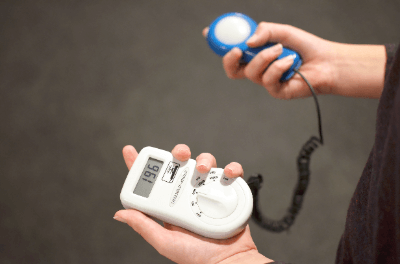What Is an Illuminance Meter?

An illuminance meter is a machine that measures the brightness of a place.
In our daily lives, schools, workplaces, etc., it is necessary to have appropriate illuminance in our work environment. Illuminance is expressed in units of lux. There are two types of illuminance meters: the photocell type, which does not require a power supply, and the photoelectric tube type, which can measure illuminance down to low levels.
Principle of Illuminance Meters
An illuminance meter measures and quantifies the brightness of a lighted area, measuring the luminous flux per unit area (lm: lumens). The illuminance meter’s sensitivity to light wavelengths matches the sensitivity of the human eye, and it obeys the cosine law for light emitted at an angle. The cosine law is a law that states that the luminous intensity Iθ from an evenly diffused area to a certain direction is proportional to the cosine of the angle θ formed with the luminous intensity in the direction normal to this area. This can be expressed in terms of a conductor as follows.
Iθ = In cosθ
The light-receiving part of the illuminance meter consists of a photodiode that converts light into an electrical signal, an optical filter to match the sensitivity of the human eye, and a diffusing globe to follow the cosine law.
Regarding the sensitivity of the human eye, with a peak at 555 nm, the sensitivity of 380 to 780 nm, with a mountain-shaped wavelength selection in the region of 380 to 780 nm.
Therefore, illuminance (lux) itself is also detected within this range.
How to use an Illuminance Meter
The illuminance meter is very easy to use. Just press the measurement button on the illuminance meter, and the measured value will be displayed. Most illuminance meters are large enough to be easily carried by hand and can be easily used in a variety of situations. However, depending on how you use the meter, you may not get the correct measured value.
The following are points to be considered when using these instruments.
1. Effect of Reflected Light
Illuminance meters are affected not only by direct incident light from the light source but also by reflected light. Since the illuminance meter can be affected by reflected light from the hand, face, and clothing of the person being measured, it is necessary to take measures such as bending down as much as possible and wearing clothing with low reflectance.
2. Size of a Light Source to be Measured
When the light source of a filter-type illuminance meter is a narrow beam of light, the path of light reaching the light-receiving element varies depending on the angle, which affects the measured value. When measuring a spotlight that is smaller than the illuminance receiving area of the illuminance meter, care should be taken to consider a different measurement method.
3. Distance between Light Source and Illuminance Meter Receiver
In filter-type illuminance meters, the closer the distance between the light source and the illuminance meter is, the more the light incident on the illuminance meter is angled, resulting in an error. Normally, a distance of about 1 m or more from the light source to the illuminance meter is sufficient to avoid problems.
In addition, standards and measurement methods are established when checking for a safe and comfortable environment in schools, workplaces, factories, and other places. It is necessary to understand the purpose of use and measurement conditions of the measuring instruments and to use them correctly.
Types of Illuminance Meters
Various types of illuminance meters are based on measurement range, accuracy, and ease of use.
Analog illuminance meters are used to simply check the light intensity of fluorescent lamps and the like. They are also used when you want to fix them to a specific location and measure them periodically.
Digital illuminance meters have a wide measurement range and are useful for measuring various locations, such as indoors and outdoors. There are types with separate light-receiving and display sections, which are useful when the measurement locations are far apart. They can be used for a wide range of applications.
As for the measurement range, the range that can be measured differs from illuminance meter to illuminance meter, but some types can switch the specific range in stages.